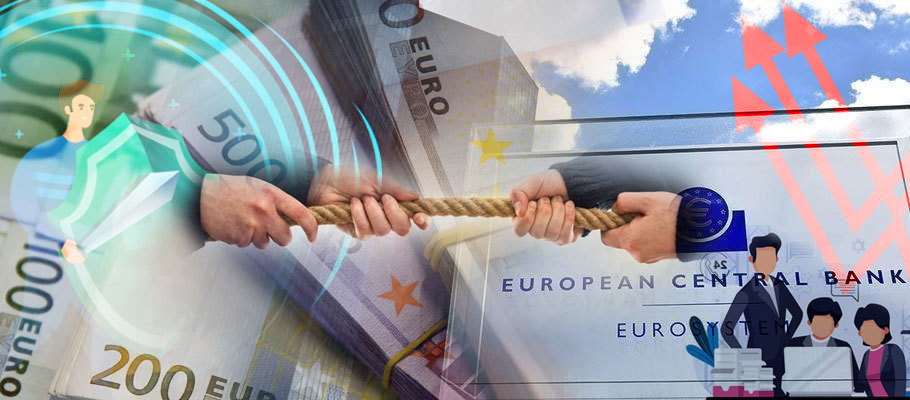
Published: July 5th, 2023
The Euro began July softer across the board following a new Eurozone inflation print for June that fell below consensus expectations and indicated price pressures were easing across the trading bloc.
Evidence that inflation may be on its way back down to the ECB’s two per cent target sent EUR earthward, falling back against all its G10 currency peers as traders continued to trim expectations for the European Central Bank's (ECB) peak policy rate.
Headline HICP figures released by Eurostat showed that inflation was 5.5 per cent higher in June, but down from 6.2 per cent in May and beneath the 5.6 per cent that economists and institutional analysts were anticipating.
Eurostat did capture a small uptick in the month-on-month figure, which rose to 0.3 per cent in June from 0 per cent in May and north of the consensus expectation of 0 per cent. The core inflation measure, however, is the one that has the greatest influence on central bank policymakers.
It takes out variables like food and energy prices and came in at 0.3 per cent month-on-month. That was less than the consensus expectation of 0.7 per cent, though slightly above the previous month's 0.2 per cent.
The greatest upward pressure came from Germany, which posted a 0.3% month-on-month rise in June headline inflation over -0.1 per cent recorded in May. However, German core inflation still fell below market expectation, hitting 0.3 per cent in June, while consensus was looking for 0.7 per cent.
In France, core inflation rose 4.5 per cent for the 2023 year-to-date, undercutting expectations for 4.6 per cent and under May's published 5.1 per cent figure.
In early May the Euro found itself in a similar situation, falling back against all its G10 peers except for the mighty USD. EUR only rose in relation to the Brazilian Real, Turkish Lira and Chinese Renminbi on the broader G20 table, however some analysts said it could remain a laggard for the near term.
EUR started experiencing losses when European Central Bank (ECB) President Christine Lagarde said on 3rd May that interest rates would likely be raised again soon, only holding steady until Frankfurt policymakers believed that their monetary decisions have become restrictive enough to send inflation back down to the central bank’s two per cent target.
The Euro experienced further declines when German state statistics agency Destatis announced that the country’s manufacturing orders fell more than 10 per cent in March, the biggest one-month decline since the onset of the pandemic. The print followed a Eurostat print which indicated that European retail sales dropped a full percentage point in the same month.
An analyst note from Nomura in London said that the broad EUR rally underway since last week ‘is done. EURUSD seems stuck below 1.1100 and most EUR crosses have recently spun lower.’
Whether or not the most recent economic data proves that a downturn is underway remains to be seen. Nomura says, however, that investors have realised the risk and may now be pricing-in a negative direction of travel, particularly as the ECB has unleashed its most hawkish monetary tightening on record. Traders will be watching to see what the impact will be on the Eurozone’s real economy.
That makes Europe's economic data calendar particularly important. A cascade of negative signals from the EU’s biggest economies could trigger forex traders to reprice their outlook for ECB interest rates.
It's not the first time this year that EUR has been on the back foot. Forex analysts at MUFG said in February that USD’s ongoing comeback wasn’t being hindered by risk-off sentiment, or trader concerns about signals from the US Fed’s open markets committee.
As investors shrugged off PCE deflator data due the same week, MUFG said markets might be witnessing the return of Dollar dominance.
‘The upward adjustment to a higher terminal rate and cooling rate cut expectations for later in 2023 have spurred new life into the strong USD trade we saw at the end of 2022,’ says MUFG’s briefing.
Adding wind to USD’s sails is a lifting of investor expectations about the timing of the Federal Reserve's peak interest rate hiking cycle.
In January, consensus had the last rate rise set for March, but an additional two hikes have since been added to the table.
The likelihood of a rate cut in the latter part of 2023 has receded, giving the Dollar support after an underwhelming end to 2022 and beginning to 2023.
EURUSD rushed toward 1.10 in January but fell back in early February as new US economic data flummoxed analysts by sending mixed signals to the market.
An unexpected blend of strong wage data, labour market dynamics, inflation figures and retail sales pointed to an American economy robust enough to achieve the Fed’s above-target inflation levels. EURUSD started to retrace previous gains as a result.
In April 2022, spiking oil prices were pushing the Euro toward multi-year lows as forex traders bet that the European Central Bank would delay plans to raise interest rates later in the year.
Prices for Brent Crude surged above USD 130 per barrel in March 2022, the highest level for almost 13 years. Wholesale gas prices meanwhile more than doubled from the previous month on fears that the US and EU were considering an unequivocal ban on Russian oil.
The US did move forward with plans to ban purchases of Russian oil and gas, with other G7 countries following suit. European natural gas prices responded by hitting an all-time high.
In a note to investors, the FX Strategy unit at Crédit Agricole wrote that news of major Western importers considering coordinated sanctions against Russian energy exports sent oil and other commodity prices soaring, especially in Asia.